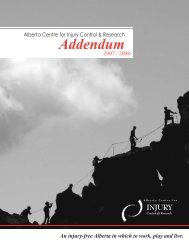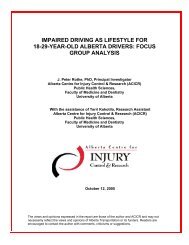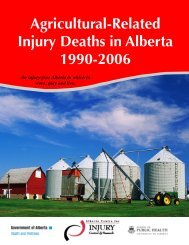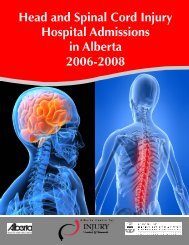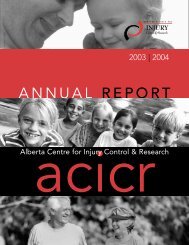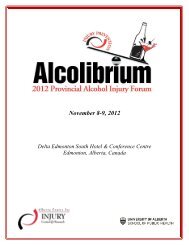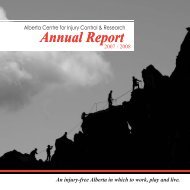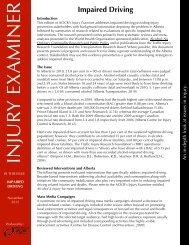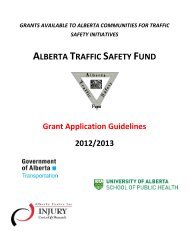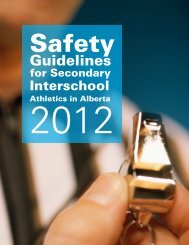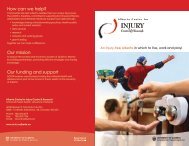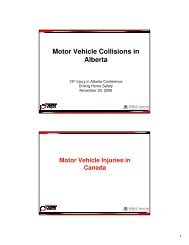JUNE 2003 - Alberta Centre for Injury Control & Research
JUNE 2003 - Alberta Centre for Injury Control & Research
JUNE 2003 - Alberta Centre for Injury Control & Research
You also want an ePaper? Increase the reach of your titles
YUMPU automatically turns print PDFs into web optimized ePapers that Google loves.
• Between 1990 and 1996, 4,678 hospitalizations occurred <strong>for</strong> farm injuries in<br />
<strong>Alberta</strong>.<br />
• The overall ratio of male:female farm hospitalizations in <strong>Alberta</strong> was 10:1<br />
<strong>for</strong> machinery and 3:1 <strong>for</strong> non-machinery.<br />
• 20% of the hospitalized farm injuries were machinery injuries, the remaining<br />
80% were not machine related injuries such as animals, overexertion, falls,<br />
etc.<br />
Occupational injuries<br />
The workplace is another environment where injuries can occur. Working<br />
people spend a large part of their day in workplaces doing jobs where the<br />
potential <strong>for</strong> a wide range of injuries is possible. ACICR examined data from<br />
<strong>Alberta</strong> Labour, Occupational Injuries and Disease in <strong>Alberta</strong> and provided<br />
the following in<strong>for</strong>mation. 26<br />
• In <strong>Alberta</strong> in 1999, 35,440 workplace injuries or disease occurred that were<br />
serious enough to miss at least one day of work.<br />
• Industry sectors with higher than average lost time claim rates were<br />
Manufacturing and Processing, Construction and Construction Trade<br />
Services, Communication and Utilities, and Agriculture and Forestry.<br />
• Workers who had worked <strong>for</strong> their current employer less than six months<br />
were more likely to have lost time claims due to work-related injury or<br />
disease.<br />
• Sprains, strains and tears were the most common type of lost time injury.<br />
• Median workdays lost due to work-related injury and disease was 9 days.<br />
• 114 occupational fatalities were accepted by the WCB in 1999: 33% were<br />
occupational disease; 29% motor vehicle incidents; 32% workplace<br />
incidents.<br />
Drowning<br />
Data on drownings collected and maintained by the Lifesaving Society in<br />
<strong>Alberta</strong> were also examined. 27 The facts on drowning in <strong>Alberta</strong> in 2000<br />
follow.<br />
• 31 drownings occurred in <strong>Alberta</strong> in 2000.<br />
• The high-risk age category was among young adults aged 18-24.<br />
• Boaters represented the largest number of drowning victims with recreational<br />
swimmers representing the second largest number of drowning victims.<br />
• The majority of drownings occurred in natural bodies of water.<br />
• 43.5% of all drownings were alcohol-related from 1996-2000.<br />
• From 1991 to 2000, 87 boating deaths occurred. Of these deaths, less than<br />
81% were wearing personal flotation devices.<br />
Making <strong>Alberta</strong> the Safest Place to Live<br />
79



